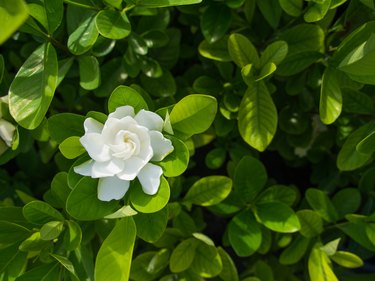
Though it can be pruned into a tree form, the common gardenia (Gardenia jasminoides) is actually an evergreen shrub, and its size depends on the cultivar. Some gardenia varieties are as tall as a person, while others are short enough to be used as ground cover or to be grown in pots. Gardenias are invariably prized for their fragrant, creamy white blooms. They are hardy in USDA zones 8 to 11.
Gardenia Tree Height
Video of the Day
Native to Asia, most common gardenia shrubs are between 3 and 8 feet tall. Larger gardenia varieties, such as the extremely popular 'Mystery' cultivar, have heights between 4 and 6 feet and feature double blooms. There are also smaller reblooming cultivars from which you can choose such as 'Chuck Hayes,' which is one of the most hardy gardenia varieties available and is about 4 feet tall.
Video of the Day
There are also dwarf gardenia cultivars that can easily be grown in containers indoors. They include the creeping gardenia (Gardenia jasminoides 'Radicans Variegata'), which has a maximum height of 2 feet. The 'Fragrant Pathways' variety is even smaller, usually growing between 8 and 10 inches tall, and it can therefore be used as ground cover.
Best Fertilizer for Gardenias
Gardenias like soil that is rich in organic matter, so work compost or shredded bark into the soil and till it before planting. Gardenias need acidic soils with a pH below 6.0; therefore, you should reach for fertilizers with acid-based formulas, like those created for azaleas. Apply a well-balanced azalea fertilizer in the spring and again six weeks later, which will help the gardenia shrubs grow faster. Add an iron supplement if you ever notice that the leaves are turning yellow. This is a condition called chlorosis.
Fall is the best time for planting gardenias. However, avoid fertilizing gardenias in autumn, as this can stimulate new growth that may not make it through the winter. If you are growing gardenias indoors, apply an acidic liquid fertilizer beginning in March and continuing until August.
Caring for Gardenias
Gardenias are not easy plants to grow. They are picky not just about soil and fertilizer but also when it comes to sun and water. Gardenias can handle full sun, but they grow best in partial shade, which is defined as four hours of sun a day. Provide gardenias with at least 1 inch of water a week and do not let the soil dry out between waterings, which can cause bud drop. A layer of mulch 2 to 4 inches thick will help keep the soil moist.
Gardenias need ample room for their roots to expand, so keep this in mind when deciding where to plant them. If you are growing gardenia plants indoors in pots, provide bright light as well as a humid environment to mimic the tropical climate of their native habitat. You can achieve this by misting the gardenia plants regularly, using a humidifier or placing the pots that contain the gardenia plants on top of a layer of wet pebbles. Never leave gardenias in standing water, however.